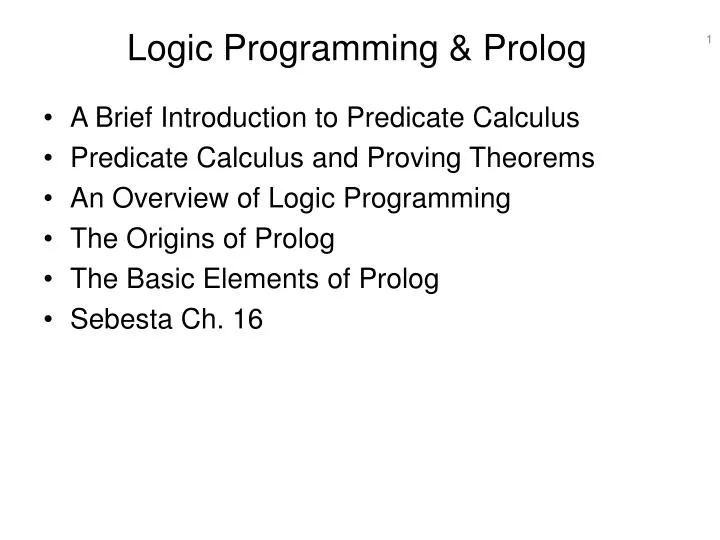Prolog: The Cornerstone of Logic Programming

Introduction

Prolog (Programming in Logic) is a high-level programming language that emerged in the early 1970s. Unlike imperative languages like C or Java, Prolog is a declarative language, which means it focuses on defining relationships and facts rather than specifying the exact steps to follow. This unique approach has made Prolog particularly well-suited for logic programming, a paradigm that emphasizes logical reasoning and knowledge representation.

Logic Programming in Prolog
Logic programming in Prolog is based on the principles of first-order logic. A Prolog program consists of a set of facts and rules that define relationships between objects and their properties. Facts assert statements as true, while rules specify implications between different facts.
For example, the following Prolog code defines a fact that John is a father:
father(john).And the following rule defines the implication that all fathers have children:
father(X) :- parent(X, Y).Syntax and Structure
Prolog code is structured into clauses, which consist of a head and a body. The head of a clause is a single fact or goal, while the body is a list of conditions or subgoals that must be satisfied for the head to be true.
Clauses are separated by periods (.). A clause with an empty body is called a fact, while a clause with a non-empty body is called a rule.
Inference and Searching
Prolog uses a technique called backward chaining for inference. Given a goal, Prolog attempts to find a clause whose head matches the goal. If a match is found, Prolog recursively tries to satisfy the subgoals of the clause body.
This process continues until all subgoals are satisfied or until a contradiction is encountered. A contradiction occurs when conflicting statements are inferred, indicating that the goal cannot be proven.
Applications of Prolog
Prolog has been widely used in various fields, including:
- Artificial Intelligence: Prolog’s logical reasoning capabilities make it ideal for tasks like natural language processing, expert systems, and theorem proving.
- Databases: Prolog’s knowledge representation features allow it to be used for flexible querying and knowledge management.
- Web Development: Prolog can be used for developing semantic web applications, where data is represented in a logical format.
- Education: Prolog is often used as a teaching language to introduce students to logic and problem-solving.
Key Features of Prolog
- Declarative Paradigm: Prolog focuses on defining relationships rather than specific execution steps.
- Logic Programming: Based on first-order logic, Prolog enables logical reasoning and knowledge representation.
- Inference Engine: Prolog uses a backward-chaining inference engine to prove goals and resolve queries.
- Pattern Matching: Prolog employs pattern matching to find clauses that match given goals or facts.
- Recursion: Prolog supports recursion, allowing for the definition of rules that refer to themselves.
Conclusion
Prolog remains a cornerstone of logic programming, providing a unique and powerful approach to problem-solving and knowledge representation. Its logical foundations, declarative syntax, and inference engine make it well-suited for applications in artificial intelligence, databases, web development, and education. As the field of logic programming continues to evolve, Prolog will undoubtedly continue to play a vital role in the advancement of knowledge-based systems.## Prolog: The Cornerstone Of Logic Programming
Executive Summary
Prolog, short for PROgramming in LOGic, is a declarative logic programming language used for developing expert systems, natural language processing, and knowledge representation. Its unique approach to problem-solving, based on logical reasoning, sets it apart from traditional imperative programming languages. This article delves into the fundamentals of Prolog, exploring its syntax, semantics, and key features, and highlights its applications in various domains.
Introduction
Logic programming emerged in the 1970s as a revolutionary approach to computer science, introducing a paradigm shift from imperative programming to declarative programming. Prolog, developed by Alain Colmerauer and Robert Kowalski, embodies this paradigm, offering a powerful tool for representing and manipulating knowledge and reasoning about it.
FAQs
Q1: What is the fundamental difference between Prolog and imperative programming languages?
A: Prolog is a declarative language, while imperative languages are procedural. In Prolog, one describes what a program is supposed to do, rather than how it should do it.
Q2: What are the key features of Prolog?
A: Prolog features pattern matching, unification, backtracking, and a built-in database, enabling efficient knowledge representation and logical reasoning.
Q3: What are Prolog’s primary applications?
A: Prolog finds applications in expert systems, natural language processing, automated theorem proving, and database querying.
Key Subtopics
1. Syntax and Semantics
- Syntax: Prolog programs consist of clauses, facts, and rules, which define relationships between terms.
- Semantics: Prolog uses a formal logic system to interpret and execute programs, inferring new knowledge from existing facts and rules.
2. Unification
- Definition: Unification is a fundamental operation in Prolog that matches terms, considering variables as placeholders that unify with other terms.
- Importance: Unification allows Prolog to automate pattern matching and facilitates logical reasoning.
3. Pattern Matching
- Concept: Prolog uses pattern matching to find matching patterns in terms.
- Benefits: Enables flexible data retrieval and efficient knowledge representation.
4. Backtracking
- Mechanism: Backtracking allows Prolog to explore alternative solutions when a computation branch fails.
- Significance: Facilitates problem-solving by systematically retracing steps to find potential solutions.
5. Database Management
- Integration: Prolog incorporates a built-in database, allowing users to store and query information.
- Advantages: Simplifies data manipulation and enhances knowledge representation capabilities.
Conclusion
Prolog stands as a cornerstone of logic programming, offering a unique and powerful approach to problem-solving. Its declarative nature and built-in mechanisms for knowledge representation, reasoning, and database management make it an ideal choice for applications in domains such as artificial intelligence, natural language processing, and expert systems. Prolog’s ability to handle complex relationships and draw inferences from incomplete or uncertain information further enhances its potential in developing intelligent systems.
Keyword Tags
- Prolog
- Logic Programming
- Declarative Programming
- Artificial Intelligence
- Knowledge Representation
